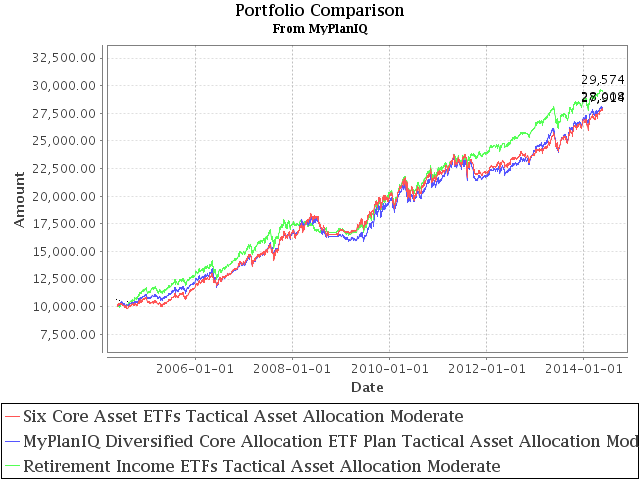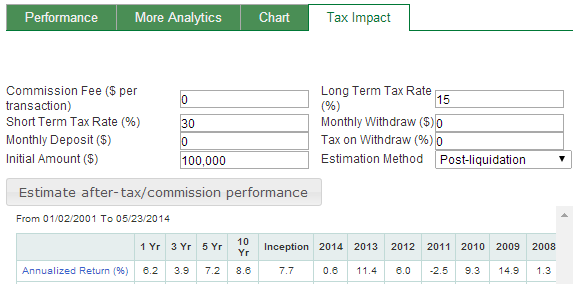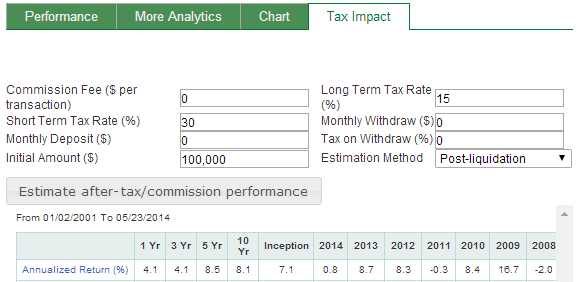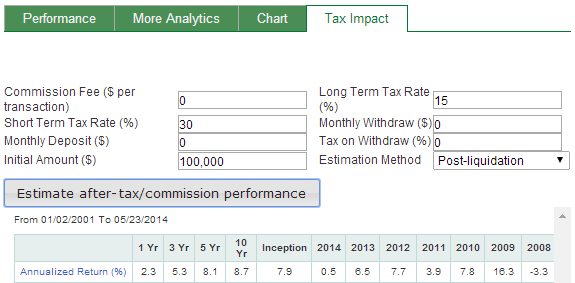Re-balance Cycle Reminder All MyPlanIQ’s newsletters are archived here.
For regular SAA and TAA portfolios, the next re-balance will be on Monday, June 2, 2014. You can also find the re-balance calendar for 2013 on ‘Dashboard‘ page once you log in.
As a reminder to expert users: advanced portfolios are still re-balanced based on their original re-balance schedules and they are not the same as those used in Strategic and Tactical Asset Allocation (SAA and TAA) portfolios of a plan.
Please note that we now list the next re-balance date on every portfolio page.
In praise of low cost core asset class based portfolios
We are a firm believer in simplicity. Many greatest inventions or scientific discoveries in human history lie in some simple and elegant concepts. This is also true in investing. We have always advocated Simpler Is Better (SIB) portfolios. These portfolios are constructed out of a list of low cost major asset class index funds or ETFs. The major asset classes include the following:
- US stocks
- Developed countries stocks
- Emerging market stocks
- REITs (US or Global)
- Commodities
- US total bonds
With the advent of low cost index mutual funds such as Vanguard funds and ETFs, investors now can use these broad base liquid funds to have exposure to the above asset classes. The most representative plans are
- Six Core Asset ETFs (five Vanguard ETFs and one Powershares commodities index ETF DBC)
- Six Core Asset Index Funds (five Vanguard index mutual funds and one Powershares commodities index ETF DBC)
- Five Core Asset ETFs (no commodities exposure)
- Five Core Asset Index Funds (no commodities exposure)
In Strategic Asset Allocation portfolios, this concept of low cost index fund based diversified portfolios has been discussed and advocated widely. The famous lazy portfolios (see, for example, some of those covered on Lazy Portfolios page) are one types of examples.
In this newsletter, we focus on Tactical Asset Allocation portfolios.
Comparable performance
Though we have advocated that by expanding coverage of each asset class (especially in US stocks and bonds) at a lower level and using our fund selection (also momentum based) to choose these lower level funds at each rebalance time can result in about 1% increase of annual returns, the out performance has not been very consistent. The following is the performance comparison for the 3 featured tactical portfolios listed on our Brokerage Investors page.
Portfolio Performance Comparison (as of 5/23/2014):
| Ticker/Portfolio Name | From 2001 AR | YTD Return** |
1Yr AR | 3Yr AR | 5Yr AR | 10Yr AR | 10Yr Sharpe |
|---|---|---|---|---|---|---|---|
| Six Core Asset ETFs Tactical Asset Allocation Moderate | 9.4% | 3.7% | 10.3% | 6.9% | 9.8% | 10.8% | 0.96 |
| MyPlanIQ Diversified Core Allocation ETF Plan Tactical Asset Allocation Moderate | 9.3% | 3.2% | 9.8% | 7.4% | 11.3% | 10.9% | 0.98 |
| Retirement Income ETFs Tactical Asset Allocation Moderate | 10.3% | 2.4% | 7.0% | 8.7% | 11.4% | 11.5% | 1.09 |
**YTD: Year to Date
See year by year detailed comparison >>
One can see that six core portfolio is very comparable with the other two portfolios. In the 10 year time frame, we caution that many style or segment ETFs didn’t have that far history and thus their performance might have been affected. Nevertheless, the out performance, even in the last 5 year time frame, is bit more than 1%, though meaningful but not very large.
Lower risk
The six core asset portfolio also has the lowest maximum drawdown among the 3 portfolios.
Maximum Drawdowns (%):
| 1 Yr | 3 Yr | 5 Yr | 10 Yr | Inception | |
| Six Core | 5 | 8.8 | 9.4 | 11.4 | 11.4 |
| MyPlanIQ Diversified Core | 6.1 | 8.6 | 9.9 | 12.5 | 12.5 |
| Retirement Income ETFs | 5.6 | 7.2 | 9 | 12.1 | 13.7 |
However, the SIB story does not stop here when one examines some other factors.
Better implementation
The SIB portfolios have the following distinct advantages when it comes to implementation.
- Less rebalances: we looked at the number of rebalances from 12/31/2000 to 5/23/2014 for the two portfolios and found that Six Core Asset ETFs Tactical Asset Allocation Moderate has 50 rebalances while MyPlanIQ Diversified Core Allocation ETF Plan Tactical Asset Allocation Moderate has 108 rebalances. The more than 50% reduction of rebalance activities makes the SIB portfolios much easier to implement.
- Less trade friction: since in a SIB portfolio, one is trading ETFs that have much broader coverage on stocks or bonds, the ETFs are a lot more liquid and have much narrower bid-ask spreads, compared with narrower sector based ETFs (for example, comparing SPDR S&P 500 ETF SPY and iShares S&P Mid-Cap 400 Value ETF IJJ).
- Less market perturbation: as we are mainly trading broadest ETFs or mutual funds, it removes one of the potential worries many investors have on crowded trades (see a recent report on how such tradings can affect markets).
In addition to the obvious advantage of less rebalances one needs to carry out, cutting number of trades in half is also making the implementation less error prone.
Tax efficient
For those who are investing in their taxable accounts, the SIB portfolios have another important advantage: tax efficiency. This can make the slight out performance in returns by other sophisticated portfolios disappear.
To gauge this, we use our Tax Impact feature (one can find this tab on a portfolio page such as this one Six Core Asset ETFs Tactical Asset Allocation Moderate. The following pictures show the 3 portfolios after tax result (post-liquidation):
Six Core Asset ETFs Portfolio Post Liquidation Tax Impact
MyPlanIQ Diversified Core Portfolio Post Liquidation Tax Impact
Retirement Income ETFs Portfolio Post Liquidation Tax Impact
You are encouraged to input other tax rates or other parameters to see how they affect the final returns.
In the above, it is obvious that Six Core portfolio is now pretty in par with other portfolios in terms of after tax returns. The tax efficiency advantage of the SIB portfolios is very compelling.
Summary
Based on the above analysis, we believe for many average investors or for those who would like to have minimal trading activities, the SIB portfolios are very appealing and should be preferred portfolios. Only when you are in a tax deferred account (such as an IRA) and you are an active investor, you should consider using other more sophisticated portfolios.
Market Overview
Though stocks continued to ascend, we take the two notes here: first, long bonds have had considerable strength so far this year. In fact, even general bonds have done well:
| Ticker/Portfolio Name | 1 Week Return* |
YTD Return** |
1Yr AR |
|---|---|---|---|
| VTI (Vanguard Total Stock Market ETF) | 1.3% | 3.1% | 17.8% |
| VEA (Vanguard MSCI EAFE ETF) | 0.5% | 2.4% | 14.2% |
| VWO (Vanguard MSCI Emerging Markets ETF) | 0.7% | 4.6% | 2.2% |
| VNQ (Vanguard REIT Index ETF) | -0.7% | 15.6% | 3.2% |
| DBC (PowerShares DB Commodity Index Tracking) | 0.6% | 3.0% | 0.9% |
| BND (Vanguard Total Bond Market ETF) | -0.0% | 3.5% | 1.6% |
| TLT (iShares Barclays 20+ Year Treas Bond) | -0.7% | 11.7% | -0.3% |
Second, we are now in a summer season that is usually unfriendly to stocks. Considering the persistent heightened stock levels, we believe this is not a time to be complacent though, as usual, we will let the markets sort out their trends.
For more detailed asset trend scores, please refer to 360° Market Overview.
We would like to remind our readers that markets are more precarious now than other times in the last 5 years. It is a good time and imperative to adjust to a risk level you are comfortable with right now. However, recognizing our deficiency to predict the markets, we will stay on course.
We again copy our position statements (from previous newsletters):
Our position has not changed: We still maintain our cautious attitude to the recent stock market strength. Again, we have not seen any meaningful or substantial structural change in the U.S., European and emerging market economies. However, we will let markets sort this out and will try to take advantage over its irrational behavior if it is possible.
We again would like to stress for any new investor and new money, the best way to step into this kind of markets is through dollar cost average (DCA), i.e. invest and/or follow a model portfolio in several phases (such as 2 or 3 months) instead of the whole sum at one shot.
Latest Articles
- May 19, 2014: Consistency, The Most Important Edge In Investing: Strategic Case
- May 12, 2014: How To Handle An Elevated Overvalued Market
- May 5, 2014: Asset Allocation Funds Review
- April 28, 2014: Now The Economy Backs To The ‘Old Normal’, Should Our Investments Too?
- April 21, 2014: Total Return Bond Investing In The Current Market Environment
- April 14, 2014: Momentum Stocks Crashed, How About Momentum Tactical Allocation?
Enjoy Newsletter
How can we improve this newsletter? Please take our survey
–Thanks to those who have already contributed — we appreciate it.





